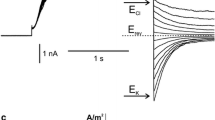Abstract.
The giant marine alga Valonia utricularis is a classical model system for studying the electrophysiology and water relations of plant cells by using microelectrode and pressure probe techniques. The recent finding that protoplasts can be prepared from the giant ``mother cells'' (Wang, J., Sukhorukov, V.L., Djuzenova, C.S., Zimmermann, U., Müller, T., Fuhr, G., 1997, Protoplasma 196:123–134) allowed the use of the patch-clamp technique to examine ion channel activity in the plasmalemma of this species. Outside-out and cell-attached experiments displayed three different types of voltage-gated Cl− channels (VAC1, VAC2, VAC3, Valonia Anion Channel 1,2,3), one voltage-gated K+ channel (VKC1, Valonia K + Channel 1) as well as stretch-activated channels. In symmetrical 150 mm Cl− media, VAC1 was most frequently observed and had a single channel conductance of 36 ± 7 pS (n= 4) in the outside-out and 33 ± 5 pS (n= 10) in the cell-attached configuration. The reversal potential of the corresponding current-voltage curves was within 0 ± 4 mV (n= 4, outside-out) and 9 ± 7 mV (n= 10, cell-attached) close to the Nernst potential of Cl− and shifted towards more negative values when cell-attached experiments were performed in asymmetrical 50:150 mm Cl− media (bath/pipette; E Cl− −20 ± 7 mV (n= 4); Nernst potential −28 mV). Consistent with a selectivity for Cl−, VAC1 was inhibited by 100 μM DIDS (4,4′-diisothiocyanatostilbene-2,2′-disulfonic acid). VAC1 was activated by a hyperpolarization of the patch. Boltzmann fits of the channel activity under symmetrical 150 mm Cl− conditions yielded a midpoint potential of −12 ± 5 mV (n= 4, outside-out) and −3 ± 6 mV (n= 9, cell-attached) and corresponding apparent minimum gating charges of 15 ± 3 (n= 4) and 18 ± 5 (n= 9). The midpoint potential shifted to more negative values in the presence of a Cl− gradient.
VAC2 was activated by voltages more negative than E Cl− and was always observed together with VAC1, but less frequently. It showed a ``flickering'' gating. The single channel conductance was 99 ± 10 pS (n= 6). VAC3 was activated by membrane depolarization and frequently exhibited several subconductance states. The single channel conductance of the main conductance state was 36 ± 5 pS (n= 5). VKC1 was also activated by positive clamped voltages. Up to three conductance states occurred whereby the main conductance state had a single channel conductance of 124 ± 27 pS (n= 6).
In the light of the above results it seems to be likely that VAC1 contributes mainly to the Cl− conductance of the plasmalemma of the turgescent ``mother cells'' and that this channel (as well as VAC2) can operate in the physiological membrane potential range. The physiological significance of VAC3 and VKC1 is unknown, but may be related (as the stretch-activated channels) to processes involved in turgor regulation.
Similar content being viewed by others
Author information
Authors and Affiliations
Additional information
Received: 24 June 1999/Revised: 2 September 1999
Rights and permissions
About this article
Cite this article
Heidecker, M., Wegner, L. & Zimmermann, U. A Patch-Clamp Study of Ion Channels in Protoplasts Prepared from the Marine Alga Valonia utricularis . J. Membrane Biol. 172, 235–247 (1999). https://doi.org/10.1007/s002329900600
Issue Date:
DOI: https://doi.org/10.1007/s002329900600




